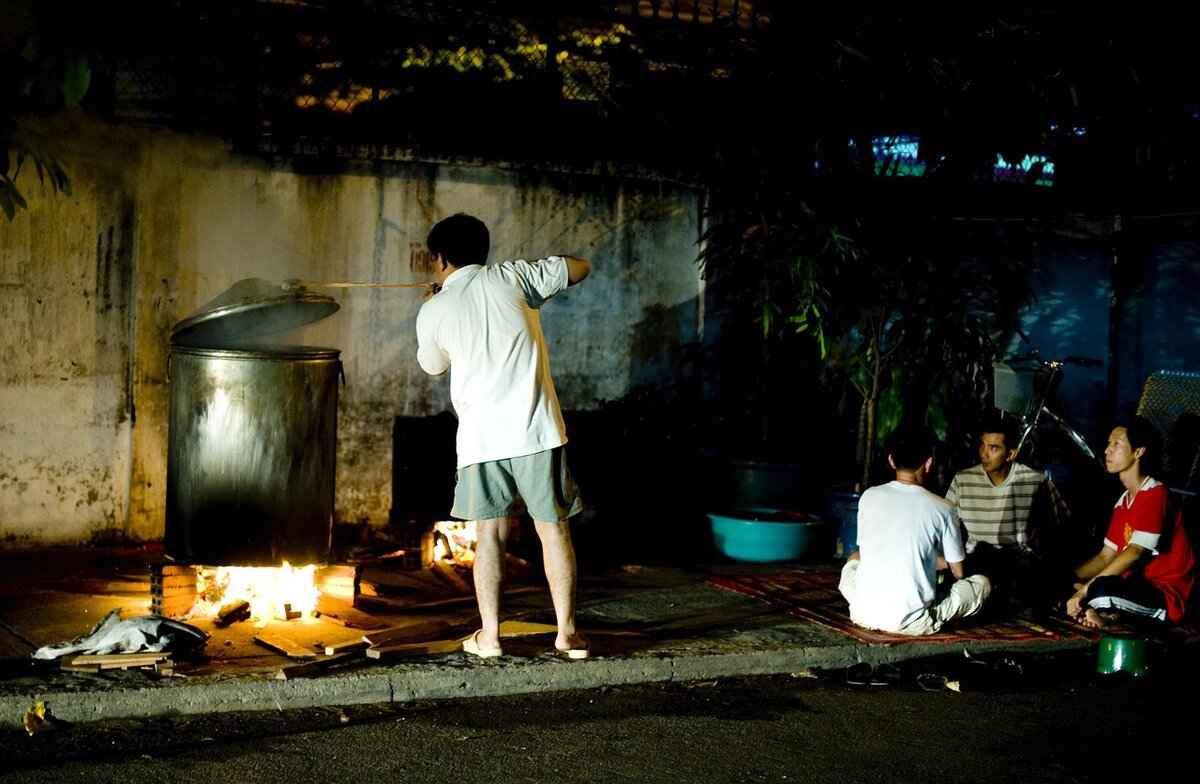Discover the vibrant culinary landscape of Ho Chi Minh City, where local flavors and traditional dishes create an unforgettable dining experience. The city is a melting pot of cultures, and its cuisine reflects this diversity. To truly eat like a local, you must explore the must-try dishes that define the essence of Vietnamese food.
What Are the Signature Dishes of Ho Chi Minh City?
Ho Chi Minh City is renowned for its diverse culinary offerings. Here are some signature dishes that every visitor should sample:
- Pho: This iconic noodle soup is a staple in Vietnamese cuisine.
- Banh Mi: A delicious sandwich that combines French and Vietnamese flavors.
- Goi Cuon: Also known as fresh spring rolls, these are a healthy and tasty option.
- Com tam: Broken rice served with various toppings, a local favorite.
Why Is Pho a Must-Try Dish?
Pho is not just a meal; it’s a cultural experience. This beloved Vietnamese noodle soup has deep roots in the country’s history and is enjoyed by locals and tourists alike. The dish typically consists of broth, rice noodles, herbs, and meat, usually beef or chicken. Its variations can be found throughout the city, each with unique flavors and preparations.
How Is Pho Traditionally Served?
Understanding how Pho is traditionally served enhances the dining experience. Typically, it comes with a side of fresh herbs like basil and cilantro, lime wedges, and chili slices, allowing diners to customize their bowls according to personal taste.
What Ingredients Make Up the Perfect Pho?
The secret to a delicious bowl of Pho lies in its ingredients. A well-prepared broth is essential and is usually made by simmering beef bones, spices, and herbs for several hours. The noodles are made from rice, and the dish is garnished with fresh herbs and vegetables, making it a flavorful and aromatic experience.
What Are the Best Places to Enjoy Pho?
Finding the right spot to savor Pho can elevate your experience. Some local eateries known for serving authentic Pho include:
- Pho Hoa: Famous for its rich broth and tender meat.
- Pho 2000: A popular spot where former U.S. President Bill Clinton dined.
- Pho Le: Known for its unique flavors and generous portions.
What Other Noodle Dishes Should You Try?
Beyond Pho, Ho Chi Minh City offers a variety of noodle dishes worth exploring. Some of these include:
- Bun Thit Nuong: Grilled pork over vermicelli noodles.
- Hu Tieu: A noodle soup with a clear broth, often served with seafood.
- Mi Quang: Turmeric noodles served with a variety of meats and herbs.
How Does Banh Mi Reflect Vietnamese Culture?
Banh Mi is more than just a sandwich; it embodies the fusion of cultures. Originating from French colonial influence, this dish combines a crispy baguette with various fillings, including meats, pickled vegetables, and sauces. It’s a perfect representation of the culinary harmony in Vietnam.
What Ingredients Are Found in a Traditional Banh Mi?
The composition of a Banh Mi sandwich is key to its appeal. Typical ingredients include:
- Grilled pork or chicken
- Pickled carrots and daikon
- Cucumber slices
- Cilantro and jalapeños
- Mayonnaise or chili sauce
Where Can You Find the Best Banh Mi in the City?
Locating the best Banh Mi spots can enhance your culinary journey. Some popular vendors known for their delicious Banh Mi include:
- Banh Mi Huynh Hoa: Famous for its generous portions and flavorful fillings.
- Banh Mi 37 Nguyen Trai: A local favorite with a variety of options.
- Banh Mi Phuong: Renowned for its fresh ingredients and unique taste.
What Is the Role of Street Food in Ho Chi Minh City?
Street food is an integral part of Ho Chi Minh City’s culture. It offers an authentic taste of local flavors and is accessible to everyone. Street vendors serve a variety of dishes, allowing visitors to experience the city’s culinary diversity firsthand.
What Are the Must-Try Street Food Dishes?
Some must-try street food items that capture the essence of local cuisine include:
- Xoi: Sticky rice often topped with mung beans or fried shallots.
- Che: A sweet dessert soup made with beans, fruits, and coconut milk.
- Goi Du Du: Green papaya salad with shrimp and peanuts.
How to Navigate the Street Food Scene Safely?
While street food is delicious, safety is essential. Here are some tips on how to enjoy street food while ensuring a safe dining experience:
- Choose vendors with a high turnover of customers.
- Look for freshly prepared food.
- Stay hydrated and avoid tap water.
What Desserts Should You Not Miss?
Vietnamese desserts are a delightful way to end a meal. Popular local desserts that are a must-try for any food lover include:
- Banana Cake: A sweet steamed cake made with ripe bananas.
- Sticky Rice with Mango: A delicious combination of sweet sticky rice and fresh mango.
- Che Ba Mau: A colorful three-color dessert made with beans, jelly, and coconut milk.
What Ingredients Are Common in Vietnamese Desserts?
Understanding the ingredients used in Vietnamese desserts can enhance appreciation. Common components include:
- Coconut milk
- Sticky rice
- Beans and legumes
- Fruits and jellies
Where to Find the Best Desserts in Ho Chi Minh City?
Finding the right place to indulge in desserts is crucial. Local bakeries and dessert shops known for their exceptional offerings include:
- Che Khuc Bach: Famous for its sweet soup and unique flavors.
- Nguyen Sinh: Renowned for its variety of traditional Vietnamese desserts.
- Sweet Dessert Shop: A popular spot for a range of sweet treats.

What Are the Signature Dishes of Ho Chi Minh City?
Ho Chi Minh City, a bustling metropolis in Vietnam, is a paradise for food lovers. With its rich cultural tapestry, the city offers a plethora of culinary delights that reflect its history and diversity. Among the myriad of dishes available, there are certain signature foods that every visitor must try to truly experience the local cuisine. This section will delve into the signature dishes of Ho Chi Minh City, highlighting their unique flavors and ingredients.
Ho Chi Minh City is renowned for its diverse culinary offerings, blending traditional Vietnamese flavors with international influences. Here are some must-try dishes that encapsulate the essence of the city:
- Pho: This iconic Vietnamese noodle soup is a staple that showcases the harmony of flavors. It consists of broth, rice noodles, and various meats, usually beef or chicken. Pho is often garnished with fresh herbs, bean sprouts, and lime, making it a refreshing meal.
- Banh Mi: A delicious fusion of French and Vietnamese cuisine, Banh Mi is a sandwich that features a crispy baguette filled with various meats, pickled vegetables, and fresh herbs. It’s a perfect representation of the city’s culinary diversity.
- Gỏi Cuốn (Spring Rolls): These fresh spring rolls are filled with shrimp, herbs, rice vermicelli, and other ingredients, all wrapped in rice paper. They are often served with a peanut or hoisin dipping sauce, making them a light and flavorful snack.
- Cao Lầu: Originating from Hoi An but popular in Ho Chi Minh City, this dish features thick rice noodles topped with slices of pork, fresh herbs, and crispy croutons. Its unique flavor comes from the use of local water and ash from certain trees.
- Hu Tieu: A noodle soup that can be served dry or with broth, Hu Tieu is made with a variety of meats, seafood, and vegetables. It is often enjoyed as a breakfast dish and is beloved for its rich and savory taste.
Each of these dishes tells a story of the city’s culinary heritage and offers a glimpse into the daily lives of its residents. To truly appreciate the flavors, it’s essential to visit local eateries and street vendors where these dishes are prepared with love and tradition.
Pho is not merely a meal; it is a cultural experience. Its origins date back to the early 20th century in northern Vietnam, and it has since evolved into a beloved dish across the country. The fragrant broth, made by simmering bones and spices for hours, is the soul of Pho. Each bowl is a masterpiece, reflecting the chef’s skill and dedication.
Understanding how Pho is traditionally served can enhance your dining experience. A typical bowl is accompanied by fresh herbs like basil, mint, and cilantro, along with lime wedges and sliced chili peppers. This allows diners to customize their Pho according to personal taste.
Beyond Pho, Ho Chi Minh City boasts a variety of noodle dishes worth exploring. Mi Quang, a turmeric-infused noodle dish from Quang Nam province, and Ban Mì Xíu Mại, a meatball sandwich, are just a couple of examples that showcase the region’s culinary creativity.
In conclusion, immersing yourself in Ho Chi Minh City’s culinary scene is a must for any visitor. Each dish offers a unique taste of the city’s rich heritage, and trying them is an adventure in itself!

Why Is Pho a Must-Try Dish?
Pho is a quintessential dish that represents the heart and soul of Vietnamese cuisine. This aromatic noodle soup is not merely a meal; it is a cultural experience that has captured the hearts of food lovers around the globe. With its rich history and diverse regional variations, Pho embodies the essence of Vietnam’s culinary landscape.
Originating from the early 20th century in Northern Vietnam, Pho was influenced by French colonialism, which introduced the concept of using beef in soups. The dish quickly gained popularity and spread throughout the country, evolving into various regional styles. In the North, Pho is typically characterized by its clear broth, flat rice noodles, and minimal garnishes. In contrast, Southern Pho features a sweeter broth, wider noodles, and a plethora of fresh herbs and bean sprouts.
One of the most fascinating aspects of Pho is its cultural significance. It is often enjoyed at breakfast, symbolizing a fresh start to the day. Families gather around steaming bowls of Pho, sharing stories and laughter, making it a communal experience. Each bowl is often customized with condiments such as lime, chili, and hoisin sauce, allowing individuals to tailor the flavors to their liking.
Furthermore, Pho is not just about the flavors; it tells a story of resilience and adaptation. During the Vietnam War, Pho became a symbol of hope and sustenance for many. Street vendors would serve this comforting dish to soldiers and civilians alike, fostering a sense of community amid turmoil. Today, Pho continues to be a source of pride for many Vietnamese people, representing their rich heritage and culinary prowess.
Understanding how Pho is traditionally served enhances the dining experience. Typically, it is presented with a bowl of broth, rice noodles, and your choice of protein, often beef or chicken. Accompaniments such as fresh herbs, lime wedges, and bean sprouts are served on the side, allowing diners to personalize their dish. This interactive element makes Pho a unique culinary experience, inviting diners to engage with their food.
The secret to a delicious bowl of Pho lies in its ingredients. A well-prepared broth is the cornerstone of this dish, requiring hours of simmering bones, spices, and aromatics to achieve the perfect flavor profile. Essential ingredients include star anise, cinnamon, ginger, and onions, which infuse the broth with depth and complexity. The choice of noodles and protein further enhances the dish, making each bowl a unique creation.
When looking for the best places to enjoy Pho in Ho Chi Minh City, several local eateries stand out. Popular spots such as Pho Hoa and Pho 2000 are renowned for their authentic flavors and bustling atmospheres. These establishments not only serve delicious Pho but also embody the vibrant street food culture of the city.
In conclusion, Pho is more than just a dish; it is a reflection of Vietnamese culture, history, and community. Its rich flavors and diverse variations invite people from all walks of life to partake in this culinary tradition. Whether enjoyed at a street stall or a fine dining restaurant, Pho remains a must-try dish for anyone seeking to experience the true essence of Vietnam.
How Is Pho Traditionally Served?
Understanding how Pho is traditionally served enhances the dining experience significantly. This iconic Vietnamese dish is not only about the flavors but also about the accompanying elements that make it a complete meal. When you sit down to enjoy a bowl of Pho, you are entering a culinary ritual that reflects the rich culture of Vietnam.
Typically, Pho is served in a large, steaming bowl filled with broth, which is the heart of the dish. The broth is usually made from simmering beef bones or chicken for several hours, allowing the flavors to develop fully. The presentation is often enhanced with a generous portion of rice noodles (bánh phở) and your choice of protein, such as thinly sliced beef or chicken, placed delicately atop the noodles.
One of the unique aspects of Pho is its array of accompaniments. When served, you will often find a plate of fresh herbs and vegetables on the side. This typically includes:
- Basil – fragrant and slightly peppery, it adds a fresh note to the dish.
- Cilantro – provides a citrusy flavor that complements the broth.
- Mint – adds a refreshing touch.
- Bean sprouts – for crunch and texture.
- Chili peppers – fresh or pickled, for those who enjoy a bit of heat.
- Lime wedges – a squeeze of lime brightens the flavors.
These accompaniments are not just for decoration; they play a crucial role in enhancing the overall flavor profile of Pho. Diners are encouraged to customize their bowls by adding herbs and lime according to their personal taste preferences. This interactive aspect of Pho makes each bowl unique and tailored to the individual’s liking.
Moreover, the experience of enjoying Pho is often communal. In Vietnam, it is common to see families and friends gathered around a table, sharing their love for this beloved dish. The atmosphere is lively, with the sounds of slurping noodles and the aroma of spices filling the air. This social aspect of dining adds to the overall enjoyment of Pho.
In many local eateries, the presentation of Pho can vary slightly. Some places might serve it with a side of hoisin sauce and sriracha, allowing diners to enhance their broth’s flavor. Others might present it with a more minimalist approach, focusing solely on the freshness of the ingredients.
Ultimately, the way Pho is traditionally served speaks volumes about Vietnamese culture. It is a dish that invites sharing, customization, and enjoyment, making it a must-try for anyone visiting Ho Chi Minh City. By understanding the traditional serving style of Pho, you can fully appreciate not only the dish itself but also the cultural significance it holds within the Vietnamese culinary landscape.
What Ingredients Make Up the Perfect Pho?
When it comes to Pho, the beloved Vietnamese noodle soup, the magic truly lies in its ingredients. Each component contributes to a symphony of flavors that makes Pho an unforgettable experience. Let’s explore the essential ingredients that come together to create the perfect bowl of Pho.
The broth is the soul of Pho, and its preparation is an art form. Traditionally, it is made by simmering beef bones for several hours, allowing the flavors to develop deeply. The addition of spices such as star anise, cinnamon, and cloves infuses the broth with aromatic notes that are characteristic of this dish. The balance of flavors is crucial, as a well-made broth sets the foundation for the entire meal.
The rice noodles, or bánh phở, used in Pho are flat and wide, providing a chewy texture that pairs perfectly with the broth. Made from rice flour and water, these noodles are typically soaked in hot water before serving to achieve the right tenderness. The quality of the noodles can significantly influence the overall experience, making it essential to choose fresh, high-quality ingredients.
While Pho can be made with various proteins, beef is the most traditional choice. Cuts such as brisket, flank, and meatballs are commonly used. Each cut brings its unique flavor and texture, enhancing the dish. For those seeking a lighter option, chicken Pho is a popular alternative, featuring tender chicken pieces that absorb the rich broth beautifully.
No bowl of Pho is complete without a generous handful of fresh herbs. Basil, cilantro, and green onions are essential for adding freshness and fragrance. Additionally, garnishes such as bean sprouts, lime wedges, and jalapeños allow diners to customize their bowl, enhancing the flavors to their liking.
To elevate the flavors even further, a selection of condiments is often served alongside Pho. Sriracha and hoisin sauce are popular choices, providing a spicy and sweet contrast to the savory broth. A dash of fish sauce can also deepen the umami flavor, making each spoonful a delightful experience.
In conclusion, the perfect bowl of Pho is a harmonious blend of high-quality ingredients, each playing a vital role in creating its unique flavor profile. From the rich broth to the fresh herbs, every component contributes to this iconic dish that has captured the hearts of food lovers around the world.
What Are the Best Places to Enjoy Pho?
When it comes to experiencing the rich culinary heritage of Vietnam, Pho stands out as a quintessential dish that every visitor must savor. However, the experience of enjoying Pho can be significantly enhanced by choosing the right spot. In Ho Chi Minh City, a plethora of local eateries serve authentic Pho, each with its unique twist on this classic noodle soup.
Finding the perfect place to enjoy Pho not only elevates the taste but also immerses you in the local culture. Each restaurant offers a different ambiance, flavor profile, and cooking style, making it essential to explore various options. Here are some of the best places in Ho Chi Minh City where you can indulge in this beloved dish:
| Restaurant Name | Location | Specialty |
|---|---|---|
| Pho Hoa | 260C Pasteur, District 3 | Beef Pho with rich broth |
| Pho 2000 | 1-3 Phan Chu Trinh, District 1 | Celebrity-favorite Pho |
| Pho Le | 413 Le Van Sy, District 3 | Chicken Pho with fresh herbs |
| Pho Thin | 13 Lo Duc, Hai Ba Trung District | Stir-fried beef Pho |
- Pho Hoa: This establishment is renowned for its rich and flavorful broth, which is simmered for hours, allowing the spices to meld beautifully. The atmosphere is bustling, reflecting the city’s vibrant energy.
- Pho 2000: A popular spot among tourists, this restaurant gained fame after being visited by former U.S. President Bill Clinton. They serve a delightful bowl of Pho that is both authentic and satisfying.
- Pho Le: Known for its fresh ingredients, Pho Le offers a unique twist with its chicken Pho, garnished with a variety of aromatic herbs that enhance the dish’s freshness.
- Pho Thin: This eatery is famous for its stir-fried beef Pho, a variation that adds a delightful crunch and texture, making it a must-try for Pho enthusiasts.
When selecting a Pho restaurant, consider the following tips:
- Local Recommendations: Ask locals for their favorite spots; they often know hidden gems that tourists might overlook.
- Freshness of Ingredients: Look for places that emphasize fresh herbs and quality meat, as these are crucial for a great bowl of Pho.
- Ambiance: Choose a restaurant that reflects the local culture, as the environment can enhance your overall dining experience.
- Line Up: A long queue often indicates a popular spot; if locals are willing to wait, it’s usually a good sign!
In conclusion, savoring Pho in Ho Chi Minh City is not just about the soup itself but also about the atmosphere and the story behind each bowl. By choosing the right eatery, you can fully immerse yourself in the rich flavors and culture of Vietnam.
What Other Noodle Dishes Should You Try?
Ho Chi Minh City, a bustling metropolis in Vietnam, is renowned for its rich culinary heritage. While Pho is often the star of the show, the city boasts a myriad of other noodle dishes that are equally enticing and worthy of exploration. Each dish tells a story and reflects the local culture, making them essential for anyone looking to experience the authentic flavors of Vietnam.
Beyond Pho, there are several noodle dishes that locals cherish. Here are some of the must-try noodle dishes:
- Bun Thit Nuong: This dish features grilled pork over vermicelli noodles, topped with fresh herbs, peanuts, and a drizzle of fish sauce. The combination of flavors and textures makes it a refreshing meal, especially during hot weather.
- Banh Canh: A thick, chewy noodle made from tapioca flour, Banh Canh is typically served in a rich broth with shrimp, crab, or pork. The dish is known for its comforting qualities and is often enjoyed as a hearty breakfast.
- Hu Tieu: Originating from the Chinese influence in Vietnam, Hu Tieu consists of flat rice noodles served in a savory broth, accompanied by a variety of meats, seafood, and fresh vegetables. The dish can be enjoyed dry or in soup form, catering to different preferences.
- Mi Quang: This vibrant dish hails from the Quang Nam province but has found a home in Ho Chi Minh City. It features turmeric-yellow rice noodles topped with a mix of meats, herbs, and crunchy peanuts, all served with a small amount of broth. The unique flavor profile is a must-try.
- Canh Bun: A lesser-known gem, Canh Bun is a noodle soup made with rice noodles and a light, aromatic broth. It is often garnished with crab, herbs, and vegetables, offering a delightful taste of local cuisine.
To truly savor these noodle dishes, exploring local eateries and street food stalls is essential. Here are some recommendations:
| Noodle Dish | Recommended Location |
|---|---|
| Bun Thit Nuong | Bun Thit Nuong Anh Tuyet |
| Banh Canh | Banh Canh Cua 14 |
| Hu Tieu | Hu Tieu Nam Vang |
| Mi Quang | Mi Quang Ba Mua |
| Canh Bun | Canh Bun Ngoc Tuyet |
Each of these locations is known for its authentic preparation and generous portions, ensuring that you experience the true essence of these noodle dishes.
In conclusion, while Pho may be the most famous noodle dish in Ho Chi Minh City, the variety of other noodle offerings available adds depth to the local culinary scene. By exploring these dishes, you will gain a greater appreciation for the diverse flavors and traditions that make Vietnamese cuisine so special.

How Does Banh Mi Reflect Vietnamese Culture?
Banh Mi is not merely a sandwich; it is a culinary symbol of Vietnam’s rich history and cultural fusion. Originating from the French colonial period, this iconic street food combines traditional Vietnamese ingredients with French baking techniques, creating a unique gastronomic experience that resonates with both locals and visitors alike.
The origins of Banh Mi can be traced back to the late 19th century when the French introduced baguettes to Vietnam. The Vietnamese adapted this bread, using rice flour to create a lighter, airier version that perfectly complements the fillings. The result is a sandwich that is not only delicious but also a reflection of Vietnam’s ability to embrace and transform foreign influences.
Today, Banh Mi comes in various regional variations, each showcasing local flavors and ingredients. In Ho Chi Minh City, the classic Banh Mi Thit is a must-try, featuring savory grilled meats, fresh vegetables, and a variety of condiments. Alternatively, in Hanoi, the Banh Mi may lean more towards pork and pate, offering a different yet equally delightful experience. Each bite tells a story of the region’s culinary heritage.
The ingredients found in a traditional Banh Mi include:
- French Baguette: Light and crispy, providing the perfect vessel for the fillings.
- Proteins: Options range from grilled pork, chicken, and beef to tofu for a vegetarian twist.
- Pickled Vegetables: Carrots and daikon radish add a refreshing crunch and tanginess.
- Fresh Herbs: Cilantro and mint enhance the sandwich with aromatic flavors.
- Spicy Sauce: Often made from chili and mayonnaise, it adds a kick to the overall taste.
As you explore Ho Chi Minh City, knowing where to find the best Banh Mi can significantly enhance your culinary journey. Local vendors and street food stalls are scattered throughout the city, with some of the most famous spots including Banh Mi Huynh Hoa and Nguyen Thi Minh Khai Street. These establishments are renowned for their quality ingredients and authentic flavors, ensuring that each sandwich is a true representation of Vietnamese culture.
Moreover, Banh Mi has transcended its humble street food origins, becoming a global phenomenon. Many restaurants worldwide now serve their interpretations of this beloved sandwich, showcasing its versatility and appeal. However, nothing compares to enjoying a freshly made Banh Mi from a local vendor while soaking in the vibrant atmosphere of Ho Chi Minh City.
In summary, Banh Mi is a culinary masterpiece that reflects Vietnam’s history, culture, and adaptability. Its harmonious blend of flavors and textures makes it a must-try for anyone visiting the city. Whether you prefer the classic version or a modern twist, indulging in a Banh Mi is an experience that captures the essence of Vietnamese street food.
What Ingredients Are Found in a Traditional Banh Mi?
The Banh Mi sandwich is a quintessential part of Vietnamese cuisine, representing a delightful fusion of flavors and textures. Its appeal lies not only in its taste but also in its unique combination of ingredients. In this section, we will explore the typical components that make up a traditional Banh Mi, highlighting why this dish is a favorite among locals.
The charm of Banh Mi lies in its ability to blend various culinary influences, particularly French and Vietnamese. This sandwich showcases a harmonious balance of flavors, making it a beloved street food option. Let’s delve into the essential ingredients that contribute to its distinctive character.
- Bread: The foundation of any Banh Mi is the bread itself. Typically, a French baguette is used, which is characterized by its crispy crust and soft interior. This bread is usually light and airy, allowing it to hold the fillings without becoming soggy.
- Proteins: A variety of proteins can be found in Banh Mi, with the most common being grilled pork, chicken, or tofu for a vegetarian option. The meats are often marinated in a mixture of soy sauce, garlic, and spices, imparting a rich flavor.
- Pâté: Another signature element is the pâté, which adds a creamy texture and depth of flavor. Typically made from liver, this ingredient reflects the French influence and enhances the overall taste of the sandwich.
- Pickled Vegetables: A crucial component of Banh Mi is the pickled carrots and daikon. These vegetables are julienned and pickled in vinegar, providing a tangy crunch that balances the richness of the meats.
- Fresh Herbs: Fresh herbs, such as cilantro and Thai basil, are added for a burst of freshness. These herbs not only enhance the flavor but also contribute to the vibrant presentation of the sandwich.
- Chilies: For those who enjoy a bit of heat, fresh chilies are often included. They can be sliced and added to taste, giving the Banh Mi an extra kick that many locals appreciate.
- Sauces: A drizzle of mayonnaise or a special sauce can elevate the Banh Mi to new heights. These sauces add creaminess and additional flavor, making each bite even more enjoyable.
The magic of Banh Mi happens when all these ingredients are layered together. The crispy baguette is sliced open and filled with the chosen protein, followed by a generous spread of pâté. Next, the pickled vegetables are added, providing a refreshing crunch, while the fresh herbs and chilies add layers of flavor. Finally, a touch of sauce ties everything together, creating a harmonious blend that is both satisfying and delicious.
The combination of textures and flavors in Banh Mi makes it a versatile option for any meal of the day. Whether enjoyed for breakfast, lunch, or dinner, it offers a quick and affordable way to experience the rich culinary heritage of Vietnam. Its accessibility and the variety of fillings available allow everyone to find a version they love.
Where Can You Find the Best Banh Mi in the City?
When exploring the bustling streets of Ho Chi Minh City, one cannot overlook the delightful Banh Mi—a sandwich that encapsulates the essence of Vietnamese street food. Locating the best Banh Mi spots can significantly enhance your culinary journey, offering a taste of tradition and innovation in every bite. Here are some popular vendors known for their delicious sandwiches.
To truly appreciate the Banh Mi, one must understand its foundational elements. A classic Banh Mi typically features a crispy baguette filled with a variety of ingredients, including:
- Meat: Common options include pork, chicken, or tofu, marinated in flavorful sauces.
- Vegetables: Fresh cilantro, pickled carrots, and daikon radish add crunch and tang.
- Condiments: Spicy chili sauce and mayonnaise enhance the overall flavor profile.
Here are some of the most recommended places to enjoy this iconic sandwich:
| Vendor Name | Location | Specialty |
|---|---|---|
| Banh Mi Huynh Hoa | 26 Le Thi Rieng, Ben Thanh, District 1 | Pork Banh Mi with a variety of toppings |
| Banh Mi 37 Nguyen Trai | 37 Nguyen Trai, District 1 | Grilled Chicken Banh Mi with house-made sauces |
| Banh Mi Phuong | 2B Phan Chau Trinh, District 1 | Vegetarian Banh Mi with tofu and fresh veggies |
The popularity of these Banh Mi vendors can be attributed to several factors:
- Quality Ingredients: They prioritize fresh, high-quality ingredients that contribute to the sandwich’s flavor.
- Authentic Recipes: Many vendors have been in business for decades, passing down traditional recipes through generations.
- Local Experience: Eating at these spots gives you an authentic taste of local culture and community.
When selecting a Banh Mi, consider the following tips:
- Texture: Look for a baguette that is crispy on the outside yet soft on the inside.
- Flavor Balance: A great Banh Mi should have a harmonious blend of savory, sweet, and spicy flavors.
- Freshness: Ensure the vegetables are fresh and the meats are well-marinated.
In conclusion, finding the best Banh Mi in Ho Chi Minh City is not just about satisfying your hunger; it’s an opportunity to immerse yourself in the local culture and culinary traditions. With so many fantastic vendors to choose from, each offering their unique twist on this beloved sandwich, your taste buds are in for a treat!

What Is the Role of Street Food in Ho Chi Minh City?
Street food in Ho Chi Minh City is not merely a culinary option; it is a vibrant expression of local culture and a significant aspect of daily life. This bustling metropolis, known for its rich history and dynamic atmosphere, boasts a street food scene that reflects the heart and soul of its people. The streets are lined with vendors offering an array of dishes, each telling a story of tradition, innovation, and community.
Why Is Street Food So Important?
Street food serves as a social connector among locals and visitors alike. It creates an environment where people gather, share meals, and exchange stories. In Ho Chi Minh City, street food is often enjoyed in a communal setting, where friends and families come together to savor their favorite dishes. This culture of sharing enhances the overall dining experience, making it as much about the people as it is about the food.
How Does Street Food Impact Local Dining Habits?
The influence of street food on local dining habits is profound. Many residents prefer the convenience and affordability of street food over traditional dining establishments. This preference not only supports local vendors but also promotes a diverse culinary landscape. With a variety of options ranging from grilled meats to fresh spring rolls, street food caters to every palate and dietary preference.
What Are the Must-Try Street Food Dishes?
- Goi Cuon (Spring Rolls) – Fresh and light, these rolls are filled with shrimp, herbs, and vermicelli, served with a peanut or hoisin sauce.
- Ban Xeo (Vietnamese Pancakes) – Crispy pancakes filled with pork, shrimp, and bean sprouts, often wrapped in lettuce leaves.
- Hu Tieu (Noodle Soup) – A flavorful broth with rice noodles, often topped with a variety of meats and fresh herbs.
- Banh Mi (Vietnamese Sandwich) – A fusion of French and Vietnamese cuisine, this sandwich is filled with meats, pickled vegetables, and fresh herbs.
How to Navigate the Street Food Scene Safely?
While indulging in street food is a delightful experience, ensuring safety is paramount. Here are some tips:
- Choose vendors with a high turnover of customers, indicating freshness.
- Observe food preparation practices to ensure hygiene standards are met.
- Start with cooked foods rather than raw items to minimize health risks.
In conclusion, street food is a cornerstone of Ho Chi Minh City’s culinary identity. It not only provides delicious and affordable meal options but also fosters a sense of community and cultural exchange. For anyone visiting the city, experiencing the street food scene is essential to understanding and appreciating the rich tapestry of Vietnamese culture.
What Are the Must-Try Street Food Dishes?
Street food in Ho Chi Minh City is a vibrant tapestry of flavors, aromas, and culinary traditions. It serves not only as a source of nourishment but also as a cultural experience, reflecting the city’s rich history and diverse influences. Here, we explore some of the must-try street food dishes that encapsulate the essence of local cuisine, offering a taste of the city’s heart and soul.
- 1. Banh Mi: This iconic Vietnamese sandwich is a delightful fusion of French and Vietnamese flavors. Stuffed with a variety of ingredients such as grilled meats, pickled vegetables, and fresh herbs, each vendor adds their unique twist. Don’t miss trying the pork belly or tofu versions!
- 2. Goi Cuon (Spring Rolls): Often referred to as fresh spring rolls, Goi Cuon is a light and refreshing dish. Made with rice paper, these rolls are filled with shrimp, herbs, and vermicelli noodles, served with a flavorful peanut or hoisin dipping sauce. They are perfect for a quick snack on the go!
- 3. Hu Tieu: This noodle soup is a beloved dish in Ho Chi Minh City. Typically made with a clear broth and a mix of meat, seafood, and vegetables, Hu Tieu is customizable with various toppings. The combination of flavors and textures makes it a favorite among locals.
- 4. Che: For those with a sweet tooth, Che is a must-try dessert. This Vietnamese sweet soup can be made with a variety of ingredients, including beans, fruits, and jellies, often served with coconut milk. Each bowl tells a story of the region’s culinary creativity.
- 5. Xoi: Sticky rice, or Xoi, is a comforting dish that can be enjoyed at any time of day. It comes in various forms, often topped with mung beans, fried shallots, or even savory meats. The texture is sticky and chewy, making it a satisfying option for street food lovers.
- 6. Bun Thit Nuong: This dish features grilled pork over vermicelli noodles, topped with fresh herbs, peanuts, and a drizzle of fish sauce. The combination of grilled meat with the coolness of the herbs creates a harmonious balance that is both refreshing and filling.
These street food dishes not only showcase the culinary diversity of Ho Chi Minh City but also offer a glimpse into the daily lives of its residents. Each dish tells a story and provides an opportunity to connect with the local culture. As you explore the bustling streets, be sure to embrace the flavors and experiences that these must-try street foods have to offer!
How to Navigate the Street Food Scene Safely?
Experiencing the vibrant street food scene in Ho Chi Minh City is a must for any food lover. However, while indulging in these delicious offerings, it is crucial to prioritize your safety. Here are some essential tips to help you navigate the street food landscape safely while enjoying the local flavors.
One of the first rules of thumb is to opt for busy food stalls. A long line of customers is usually a good sign that the food is fresh and popular. High turnover means that the ingredients are likely to be replenished frequently, reducing the risk of foodborne illnesses.
Before you dive into a meal, take a moment to assess the cleanliness of the stall. Look for:
- Clean cooking utensils and surfaces
- Proper food storage practices
- Hygienic handling of food by vendors
If you notice anything that raises concern, it’s best to move on to another stall.
Observing how food is prepared can provide insight into its safety. Vendors who cook food fresh to order are generally a safer choice. Avoid pre-cooked items that have been sitting out for extended periods, as they can harbor harmful bacteria.
While trying local drinks is part of the experience, it’s safer to stick with bottled water. This helps avoid any potential contaminants often found in tap water. Ensure that the seal on the bottle is intact before purchasing.
If you have any food allergies, communicate clearly with the vendor. While many vendors are accommodating, language barriers can sometimes complicate things. It’s advisable to learn a few key phrases in Vietnamese or use a translation app to ensure your dietary needs are understood.
Lastly, trust your instincts. If something doesn’t feel right or if a stall doesn’t seem appealing, don’t hesitate to walk away. Your health should always come first, and there are plenty of other options available.
By following these tips, you can enjoy the rich and diverse street food offerings of Ho Chi Minh City without compromising your health. Remember, the culinary adventure awaits, but safety is key to a delightful experience!

What Desserts Should You Not Miss?
When it comes to Vietnamese desserts, the options are as diverse as they are delicious. These sweet treats serve as the perfect ending to a meal, showcasing the unique flavors and ingredients that define Vietnamese cuisine. In this section, we will explore some of the most popular local desserts that every food lover should try while visiting Ho Chi Minh City.
Vietnamese desserts often incorporate fresh fruits, coconut milk, and rice, making them both refreshing and satisfying. Here are some must-try options:
- Che: This is a traditional Vietnamese dessert soup that comes in various forms. Che can be made with beans, fruits, and even jelly, all served in sweet coconut milk. Each region has its own variations, making it a delightful experience to sample different types.
- Banh Flan: A Vietnamese take on the classic crème caramel, Banh Flan is a smooth custard topped with a rich caramel sauce. It’s a popular dessert that combines French influence with local flavors.
- Xoi: While often considered a breakfast dish, sweet sticky rice (Xoi) can also be enjoyed as a dessert. It is typically topped with mung beans, coconut, or sesame seeds for added flavor.
- Fruit Salad (Goi Trai Cay): A refreshing dessert that features a mix of seasonal fruits, often drizzled with a sweet syrup or sprinkled with crushed peanuts. It’s perfect for hot days!
- Banana Cake (Banh Chuoi): This steamed banana cake is made with ripe bananas and rice flour, offering a soft and sweet treat that is both comforting and delicious.
Understanding the ingredients used in Vietnamese desserts can enhance appreciation for these sweet treats. Some common components include:
- Coconut Milk: This creamy ingredient is often used in many desserts to add richness and flavor.
- Glutinous Rice: Essential for many traditional desserts, glutinous rice provides a chewy texture that is beloved in Vietnamese cuisine.
- Fresh Fruits: Seasonal fruits like mango, lychee, and dragon fruit are frequently used, adding natural sweetness and vibrancy to desserts.
- Beans and Pulses: Various beans, such as mung beans and red beans, are commonly used in sweet soups and cakes, providing a unique flavor and texture.
Finding the right place to indulge in desserts is crucial for a delightful experience. Here are some local bakeries and dessert shops known for their exceptional offerings:
- Che Hai San: Renowned for its diverse selection of Che, this eatery is a must-visit for anyone looking to sample various types of this traditional dessert soup.
- Goc Vietnam: This cozy spot serves a variety of Vietnamese desserts, including Banh Flan and Xoi, all made with fresh, high-quality ingredients.
- Sweet Street: A popular dessert shop that offers a fusion of traditional and modern Vietnamese desserts, including unique fruit salads and innovative takes on classic sweets.
In conclusion, Vietnamese desserts are a delightful and essential part of the culinary experience in Ho Chi Minh City. From the refreshing Che to the rich Banh Flan, these sweet treats reflect the vibrant flavors and cultural heritage of Vietnam. Be sure to explore the local dessert scene to fully appreciate the sweet side of Vietnamese cuisine!
What Ingredients Are Common in Vietnamese Desserts?
Vietnamese desserts are a delightful culmination of flavors, textures, and cultural influences, making them a vital part of the country’s culinary landscape. To truly appreciate these sweet treats, it is essential to understand the common ingredients that define them.
Vietnamese desserts often incorporate a variety of ingredients that contribute to their unique taste and texture. Here are some of the most common components:
- Glutinous Rice: This sticky rice is a staple in many Vietnamese desserts. It is often used to create sweet rice cakes or as a base for various sweet dishes.
- Coconut Milk: A rich and creamy addition, coconut milk is used to enhance flavor and provide a silky texture in desserts like che (sweet soup).
- Beans: Various types of beans, such as mung beans and red beans, are commonly used. They are often sweetened and mashed to create fillings for pastries or toppings for desserts.
- Fruit: Fresh tropical fruits like mango, lychee, and jackfruit are frequently incorporated into desserts, adding natural sweetness and vibrant colors.
- Sugar: Typically, palm sugar or cane sugar is used to sweeten desserts, providing a distinct flavor profile that complements other ingredients.
The combination of these ingredients creates a harmonious balance of flavors and textures. For instance, the chewy texture of glutinous rice pairs beautifully with the creaminess of coconut milk, while the sweetness of fruit adds freshness. The use of beans not only provides nutritional value but also contributes a unique earthiness that contrasts well with sweeter elements.
Understanding the ingredients also leads to a better appreciation of the various types of desserts available in Vietnam. Here are a few popular examples:
- Che: A sweet soup that can be made with a variety of ingredients, including beans, fruits, and coconut milk.
- Banh Chung: A traditional cake made with glutinous rice, mung beans, and pork, often enjoyed during Tet (Lunar New Year).
- Sticky Rice Cakes: These are often filled with sweet or savory ingredients and wrapped in banana leaves, creating a delightful treat.
To experience these delightful desserts, visiting local markets and dessert shops in Ho Chi Minh City is a must. Street vendors often sell freshly made treats that showcase the rich variety of ingredients used in Vietnamese desserts. Don’t hesitate to ask for recommendations to discover hidden gems that serve authentic and delicious options.
In summary, the ingredients used in Vietnamese desserts are not only essential for crafting their unique flavors but also play a significant role in cultural traditions. By exploring these components, one can gain a deeper appreciation for the artistry behind each sweet creation.
Where to Find the Best Desserts in Ho Chi Minh City?
When it comes to exploring the culinary delights of Ho Chi Minh City, desserts hold a special place in the hearts of locals and visitors alike. The city is filled with an array of dessert shops and bakeries that offer a unique twist on traditional Vietnamese sweets, making it essential to know where to find the best treats. This section will guide you through some of the most popular spots that are renowned for their exceptional dessert offerings.
Vietnamese desserts are known for their vibrant flavors and textures. They often incorporate fresh fruits, coconut milk, and sticky rice, creating a delightful balance of sweetness and freshness. Each dessert tells a story, reflecting the rich cultural heritage of the region.
- Che Khuc Bach: Famous for its Che Khuc Bach, a refreshing dessert made with almond jelly, coconut milk, and fruits, this shop is a must-visit for anyone looking to cool down after a day of exploring.
- Goc Ha Thanh: Known for its variety of Vietnamese puddings, this shop offers a range of options, from banana pudding to tapioca pearls in coconut milk, ensuring there’s something for everyone.
- Nguyen Sinh: This bakery is celebrated for its traditional mooncakes and cheese tarts. Their unique flavors, such as green tea and mango, make them a favorite among dessert enthusiasts.
- Sweet & Sour: A modern twist on Vietnamese desserts, this shop offers innovative creations like fruit parfaits and ice cream rolls, perfect for those looking for something different.
Indulging in local desserts is not just about satisfying your sweet tooth; it’s about experiencing the culture and traditions of Vietnam. Each dessert often comes with a story, showcasing local ingredients and culinary techniques passed down through generations.
With so many options available, it can be challenging to choose the right dessert. Here are some tips:
- Consider Your Preferences: If you enjoy fruity flavors, opt for desserts that feature fresh fruits or fruit purees.
- Texture Matters: Some people prefer creamy desserts, while others enjoy chewy or crunchy textures. Look for options that match your preference.
- Don’t Be Afraid to Experiment: Vietnamese desserts often come with unique flavor combinations. Be adventurous and try something new!
For those with dietary restrictions, many dessert shops in Ho Chi Minh City offer vegan and gluten-free options. Always check the menu or ask the staff for recommendations to ensure you can indulge without worry.
In conclusion, exploring the dessert scene in Ho Chi Minh City is an adventure in itself. With a variety of shops offering unique and delicious options, you are sure to find something that satisfies your sweet cravings while immersing yourself in the local culture.
Frequently Asked Questions
- What is the most popular dish in Ho Chi Minh City?
The crown jewel of Ho Chi Minh City’s culinary scene is undoubtedly Pho. This iconic noodle soup is a delightful blend of flavors, and every bowl tells a story of tradition and culture.
- Can I find vegetarian options in local Vietnamese cuisine?
Absolutely! Many local eateries offer vegetarian versions of popular dishes. Just ask for “chay” when ordering, and you’ll discover a world of flavors that cater to your dietary preferences.
- Is street food safe to eat?
Yes, street food can be safe! Just look for busy stalls with high turnover, and always choose freshly cooked items. It’s like finding a hidden gem—risk it for the flavor!
- What’s the best time to try street food?
The evenings are lively, and street vendors come alive with the bustling crowd. It’s like a food festival every night, so grab a friend and dive into the local flavors!
- Are there any must-try desserts in Ho Chi Minh City?
Definitely! Don’t miss out on Che, a sweet dessert soup that’s as colorful as it is delicious. It’s the perfect way to satisfy your sweet tooth after a savory meal!














